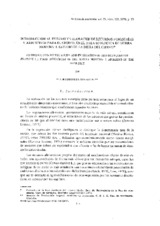Introducción al estudio y valoración de recursos forestales y arbustivos para el ciervo, en el area ecológica de Sierra Morena. 1. Estudio de la dieta del ciervo
Introduction to the study and evaluation of red deer (Cervus elaphus L.) food resources in Sierra Morena. I. Analisys of the deer diet
Autor
Rodríguez Berrocal, J.
Editor
Universidad de Córdoba, Servicio de PublicacionesFecha
1978Materia
CiervosSierra Morena (España)
Recursos forestales
Arbustos
METS:
Mostrar el registro METSPREMIS:
Mostrar el registro PREMISMetadatos
Mostrar el registro completo del ítemResumen
This work deals with botanical identification of shrubby vegetation integrating red deer (Cenus elaphus L.) diet, in the Mediterranean arca. Seasonal analysis of rurninal contens of 30 red deer yield the foliowing results : In winter about 70 p. 100 of the was of herbaceus species, 16 per cent shrubby material and the remaining 14 p. 100, fruit of trees or browse. In spring, herbaceus material remains at the same rate and the rest of ruminal contents was browse material. Summer diet was integrated by fruit of trees and shrubby plants (about 50 p. c.) while the herbaceus plants have a lower contribution (25 p. 100), the presence of browse and fruit decreases in autum, and increases the content (45 p. 100) of herbaceus species. Se realizó un estudio de los componentes de la dieta del ciervo (Cervus elaphus L.) en diferentes estaciones del año. El análisis de 30 rúmenes, obtenidos en distintas estaciones, puso de manifiesto los siguientes resultados: en invierno, alrededor del 70 p. 100 del contenido ruminal estuvo constituido por especies herbáceas, algo más del 16 p. 100 eran plantas arbustivas y arbóreas, y el resto, frutos forestales. En primavera se mantiene la proporción de especies herbáceas, y la que correspondía a los frutos forestales se acumula a la de plantas arbustivas y arbóreas, ya que en dicha estación no se detectaron frutos forestales en la dieta. En verano, las especies herbáceas se reducen al 25 p. 100; cifra ligeramente inferior a la de especies arbustivas y arbóreas. Los frutos forestales son los que predominan en la dieta, con casi un 50 p. 100. En otoño los frutos forestales se reducen a un tercio de la dieta, las especies arbustivas y arbóreas, a un 20 p. 100, y las herbáceas comienzan a recuperar su predominio en la dieta, con un 45 p. 100.

